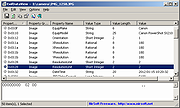Buy our over-priced crap to help keep things running.




















| Files | ||||
| File Name | Rating | Downloads | ||
| ExifDataView v1.11 ExifDataView v1.11 ExifDataView is a small utility that reads and displays the Exif data stored inside .jpg image files generated by digital cameras. The EXIF data includes the name of the company created the camera, camera model, the date/time that the photograph was taken, Exposure Time, ISO Speed, GPS information (for digital cameras with GPS), and more. System Requirements This utility works on any version of Windows, starting from Windows 2000 and up to Windows 10. Changes: Version 1.11: Fixed to read .jpg files that their EXIF information is not in the beginning of the file. Start Using ExifDataView ExifDataView doesn't require any installation process or additional dll files. In order to start using it, simply run the executable file - ExifDataView.exe After running ExifDataView.exe, you can open a .jpg file by using the 'Open File' option (Ctrl+O) or by dragging the .jpg file from Explorer into the main window of ExifDataView. After opening the .jpg file, the list of all Exif properties are displayed in the upper pane of ExifDataView. When selecting a single Exif property on the upper pane, the lower pane displays the content of the selected property as Hex Dump. You can also select one or more Exif properties in the upper pane, and then copy them to the clipboard and paste them into Excel, or save them into text/csv/xml/html file by using the 'Save Selected Items' option (Ctrl+S) Command-Line Options /LoadFile <Jpeg Filename> Load the specified .jpg file into ExifDataView. /stext <Filename> Save the Exif properties list into a regular text file. /stab <Filename> Save the Exif properties list into a tab-delimited text file. /scomma <Filename> Save the Exif properties list into a comma-delimited text file (csv). /stabular <Filename> Save the Exif properties list into a tabular text file. /shtml <Filename> ... |
 |
3,234 | Nov 03, 2020 Nir Sofer  |
|
| Showing rows 1 to 1 of 1 | Showing Page 1 of 1 | 1 |
OlderGeeks.com Copyright (c) 2025